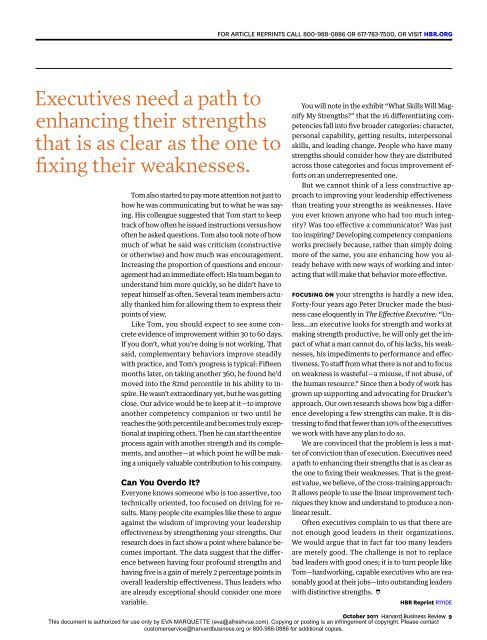W2 CELP Making Yourself Indispensable
Create successful ePaper yourself
Turn your PDF publications into a flip-book with our unique Google optimized e-Paper software.
For article reprints call 800-988-0886 or 617-783-7500, or visit hbr.org<br />
Executives need a path to<br />
enhancing their strengths<br />
that is as clear as the one to<br />
fixing their weaknesses.<br />
Tom also started to pay more attention not just to<br />
how he was communicating but to what he was saying.<br />
His colleague suggested that Tom start to keep<br />
track of how often he issued instructions versus how<br />
often he asked questions. Tom also took note of how<br />
much of what he said was criticism (constructive<br />
or otherwise) and how much was encouragement.<br />
Increasing the proportion of questions and encouragement<br />
had an immediate effect: His team began to<br />
understand him more quickly, so he didn’t have to<br />
repeat himself as often. Several team members actually<br />
thanked him for allowing them to express their<br />
points of view.<br />
Like Tom, you should expect to see some concrete<br />
evidence of improvement within 30 to 60 days.<br />
If you don’t, what you’re doing is not working. That<br />
said, complementary behaviors improve steadily<br />
with practice, and Tom’s progress is typical: Fifteen<br />
months later, on taking another 360, he found he’d<br />
moved into the 82nd percentile in his ability to inspire.<br />
He wasn’t extraordinary yet, but he was getting<br />
close. Our advice would be to keep at it—to improve<br />
another competency companion or two until he<br />
reaches the 90th percentile and becomes truly exceptional<br />
at inspiring others. Then he can start the entire<br />
process again with another strength and its complements,<br />
and another—at which point he will be making<br />
a uniquely valuable contribution to his company.<br />
Can You Overdo It?<br />
Everyone knows someone who is too assertive, too<br />
technically oriented, too focused on driving for results.<br />
Many people cite examples like these to argue<br />
against the wisdom of improving your leadership<br />
effectiveness by strengthening your strengths. Our<br />
research does in fact show a point where balance becomes<br />
important. The data suggest that the difference<br />
between having four profound strengths and<br />
having five is a gain of merely 2 percentage points in<br />
overall leadership effectiveness. Thus leaders who<br />
are already exceptional should consider one more<br />
variable.<br />
You will note in the exhibit “What Skills Will Magnify<br />
My Strengths?” that the 16 differentiating competencies<br />
fall into five broader categories: character,<br />
personal capability, getting results, interpersonal<br />
skills, and leading change. People who have many<br />
strengths should consider how they are distributed<br />
across those categories and focus improvement efforts<br />
on an underrepresented one.<br />
But we cannot think of a less constructive approach<br />
to improving your leadership effectiveness<br />
than treating your strengths as weaknesses. Have<br />
you ever known anyone who had too much integrity?<br />
Was too effective a communicator? Was just<br />
too inspiring? Developing competency companions<br />
works precisely because, rather than simply doing<br />
more of the same, you are enhancing how you already<br />
behave with new ways of working and interacting<br />
that will make that behavior more effective.<br />
Focusing on your strengths is hardly a new idea.<br />
Forty-four years ago Peter Drucker made the business<br />
case eloquently in The Effective Executive: “Unless…an<br />
executive looks for strength and works at<br />
making strength productive, he will only get the impact<br />
of what a man cannot do, of his lacks, his weaknesses,<br />
his impediments to performance and effectiveness.<br />
To staff from what there is not and to focus<br />
on weakness is wasteful—a misuse, if not abuse, of<br />
the human resource.” Since then a body of work has<br />
grown up supporting and advocating for Drucker’s<br />
approach. Our own research shows how big a difference<br />
developing a few strengths can make. It is distressing<br />
to find that fewer than 10% of the executives<br />
we work with have any plan to do so.<br />
We are convinced that the problem is less a matter<br />
of conviction than of execution. Executives need<br />
a path to enhancing their strengths that is as clear as<br />
the one to fixing their weaknesses. That is the greatest<br />
value, we believe, of the cross-training approach:<br />
It allows people to use the linear improvement techniques<br />
they know and understand to produce a nonlinear<br />
result.<br />
Often executives complain to us that there are<br />
not enough good leaders in their organizations.<br />
We would argue that in fact far too many leaders<br />
are merely good. The challenge is not to replace<br />
bad leaders with good ones; it is to turn people like<br />
Tom—hardworking, capable executives who are reasonably<br />
good at their jobs—into outstanding leaders<br />
with distinctive strengths.<br />
HBR Reprint R1110e<br />
October 2011 Harvard Business Review 9<br />
This document is authorized for use only by EVA MARQUETTE (eva@afreshvue.com). Copying or posting is an infringement of copyright. Please contact<br />
customerservice@harvardbusiness.org or 800-988-0886 for additional copies.



